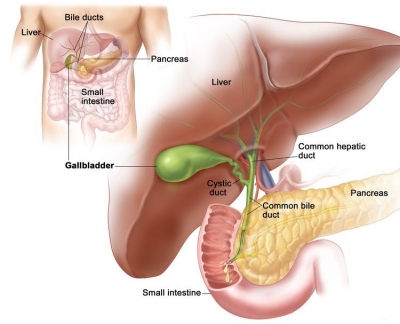
The pancreas is tucked away behind the stomach. The gallbladder sits under the liver. Tubes from both organs join together, then lead into the small intestine.
Gallbladder
The gallbladder is a small bag that stores bile it receives from the liver, concentrates it, then releases it into the duodenum. The gallbladder stores, processes, and releases bile, a liquid that helps the body to digest fat. During digestion of a meal, smooth muscles in the walls of the gallbladder contract to push bile into the bile ducts that lead to the duodenum. Once in the duodenum, bile helps with the digestion of fats.
Common bile duct
Bile from the liver is carried along this tube to the small intestine, via the gallbladder and the pancreas. Its physiological role is to carry bile from the gallbladder and empty it into the upper part of the small intestine (the duodenum). The common bile duct is part of the biliary system.
Absorbent walls
The tiny projections that make the gallbladder’s lining so absorbent. Water contained in bile soaks into the lining, making the bile more concentrated.
Pyloric sphincter
Chyme enters the duodenum from the stomach at this point. The pyloric sphincter is a band of smooth muscle at the junction between the pylorus of the stomach and the duodenum of the small intestine. It plays an important role in digestion, where it acts as a valve to controls the flow of partially digested food from the stomach to the small intestine.
Duodenum
This is the upper part of the small intestine. It is directly attached to the pylorus of the stomach. It has a C-shape, it is closely related to the head of the pancreas and consists of four sections: superior, descending, horizontal, and ascending parts. Histologically speaking, it consists of the typical three layers common to all hollow organs of the gastrointestinal tract, but it has Brunner’s glands, which is the characteristic feature of the duodenum.
Opening into the duodenum
Bile and pancreatic enzymes pour through this opening into the duodenum when food enters it from the stomach.
Inside the pancreas
The pancreas contain about over million islets of Langerhans, flower-like clusters of cells that release the hormones which help the body to store or use glucose. The islets are surrounded by cells that make digestive enzymes. Islets of Langerhans contain hormone-producing cells. Outer parts of the cluster contain digestive enzyme-producing cells.
Pancreas
Chemicals that help digestion and control blood sugar levels produced in the pancreas. The pancreas releases pancreatic juice, which is full of enzymes – chemicals that break food into smaller parts, so that they can be absorbed into the blood. It also produces hormones that control the amount of sugar in the blood. The other 99% of the pancreas contains exocrine cells that produce powerful enzymes that are excreted into the duodenum during digestion. These enzymes together with water and sodium bicarbonate secreted from the pancreas are known as pancreatic juice.
Pancreas duct
This tube carries enzymes made in the pancreas to the small intestine. The pancreatic duct joins the common bile duct just prior to the ampulla of Vater, after which both ducts perforate the medial side of the second portion of the duodenum at the major duodenal papilla. There are many anatomical variants reported, but these are quite rare.
Picture Credit : Google




